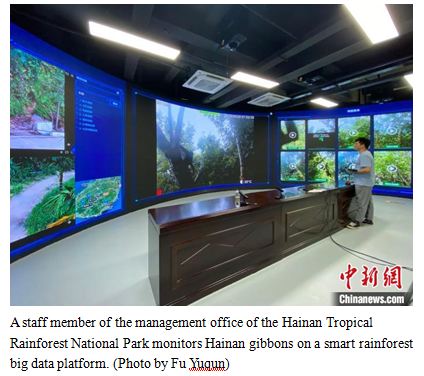By Zhao Peng, Cao Wenxuan, People’s Daily
Since the Hainan Tropical Rainforest National Park was set up as a pilot area in 2019, the southern Chinese province of Hainan has been focusing on building a new model of intelligent ecological management.
The management officeof the Hainan Tropical Rainforest National Park has built a provincial-level intelligent management center and a smart rainforest big data platform. Besides, it has also planned an integrated monitoring system for the national park, which aims to make daily patrols, animal protection, and resource monitoring smarter.
After a rain shower, Fu Huiquan, a forest ranger in the Yinggeling nature reserve of the Hainan Tropical Rainforest National Park, and his teammates went on patrolling, observing water bodies and protecting plants. They took photos, made records, and uploaded data.
As they advanced, their whereabouts were shown on a 3D map of a “Hainan Forest Ranger” mobile application. “Hainan Forest Ranger” is an intelligent application that allows forest rangers to take photos and send relevant data back to the smart rainforest big data platform.
The Hainan tropical rainforest is China’s prime example of a concentrated, diverse, well-preserved, and expansive continental island-type tropical rainforest. Paths in the pristine forest are narrow and slippery, with complex and changing conditions. Relying solely on traditional forest protection models would only result in low efficiency, and it is difficult to guarantee the personal safety of forest rangers.
Fu told People’s Daily that over ten years ago, when patrolling the mountains, they only carried a few items: machetes, compasses, and an old-fashioned camera. But now they bring smarter equipment such as satellite positioning devices, drones, and infrared cameras.
If they need to observe the overall situation of the rainforest or monitor areas that are difficult for humans to reach, they use drones for surveying. If they need rescue or spot fires or pests, they can upload photos or videos to the smart rainforest big data platform or directly connect with the platform for consultation and assistance. The upgraded equipment has made today’s patrols safer and more efficient.
The Hainan gibbon is one of the most endangered primate species in the world. The Bawangling nature reserve at the Hainan Tropical Rainforest National Park is the animal’s only habitat.
On the screens in the Bawangling nature reserve’s monitoring center, two Hainan gibbons were seen chasing and leaping through the forest, with the video closely tracking their actions as they ran and jumped.
With the help of 360-degree panoramic cameras that automatically capture and transmit the activities of the Hainan gibbons in real-time, monitoring personnel located tens of kilometers away can observe every action of the animal by simply moving their fingers.
Since the launch of the smart rainforest project in 2021, a total of 105 surveillance cameras, approximately 35 kilometers of vibration fiber optic cables, and hundreds of infrared thermal sensing triggered cameras have been installed in the Bawangling and Diaoluoshan nature reserves at the national park, building an all-encompassing “electronic fence” without any blind spot.
Wild animals’ movements are unpredictable. Relying solely on field patrols and monitoring provides limited information. However, the “electronic fence” allows for 24-hour monitoring of the surveillance areas. To minimize the impact on wildlife, all monitoring facilities have been designed to resemble trees.
The surveillance cameras and vibration fiber optic cables are placed at key points where the core areas and the general control areas converge. If unauthorized individuals or vehicles attempt to enter the core areas of the national park, these devices will alert potential risks.
“After the application of the ‘electronic fence,’ the incidents of unauthorized personnel entering the protected areas have been effectively controlled,” said Wang Nan, deputy director of the management office of the Hainan Tropical Rainforest National Park.
With the assistance of digital technology, the population of Hainan gibbons has now recovered to 37 individuals in six groups, Wang said.
Since 2019, the rainforest has revealed 54 new species to researchers. In addition, several rare and endangered species that had not been sighted there in years have reemerged – such as the water monitor and fine-spined frog.
In an ecological monitoring area in the Jianfengling nature reserve, there is a white metal box standing out amidst the lush green trees. This box is an atmospheric negative oxygen ion monitoring system, which not only monitors atmospheric negative oxygen ions but also tracks air particulate matters, temperature, humidity, wind speed, and solar radiation. It automatically transmits various monitoring data to the Jianfengling ecological data management center at regular intervals, contributing to the enhancement of rainforest conservation capabilities.
As of now, the Hainan Tropical Rainforest National Park has established four ecological observation and research stations, over 110 monitoring stations, and nearly 500 long-term dynamic monitoring sites, forming a preliminary eco-monitoring network.
Through continuous exploration, the Hainan Tropical Rainforest National Park has formulated a set of methods and systems to measure the value of tropical rainforest resources. In September 2021, it became the first national park in China to complete the accounting of gross ecosystem product, with a value of 204.5 billion yuan ($28.79 billion).



















